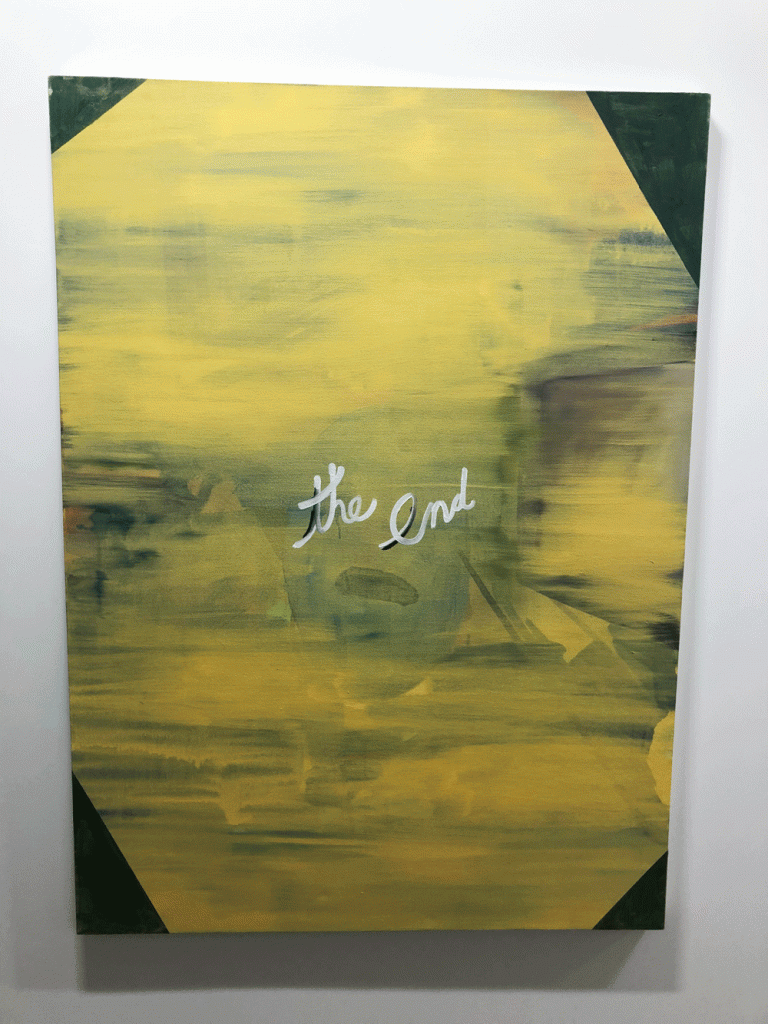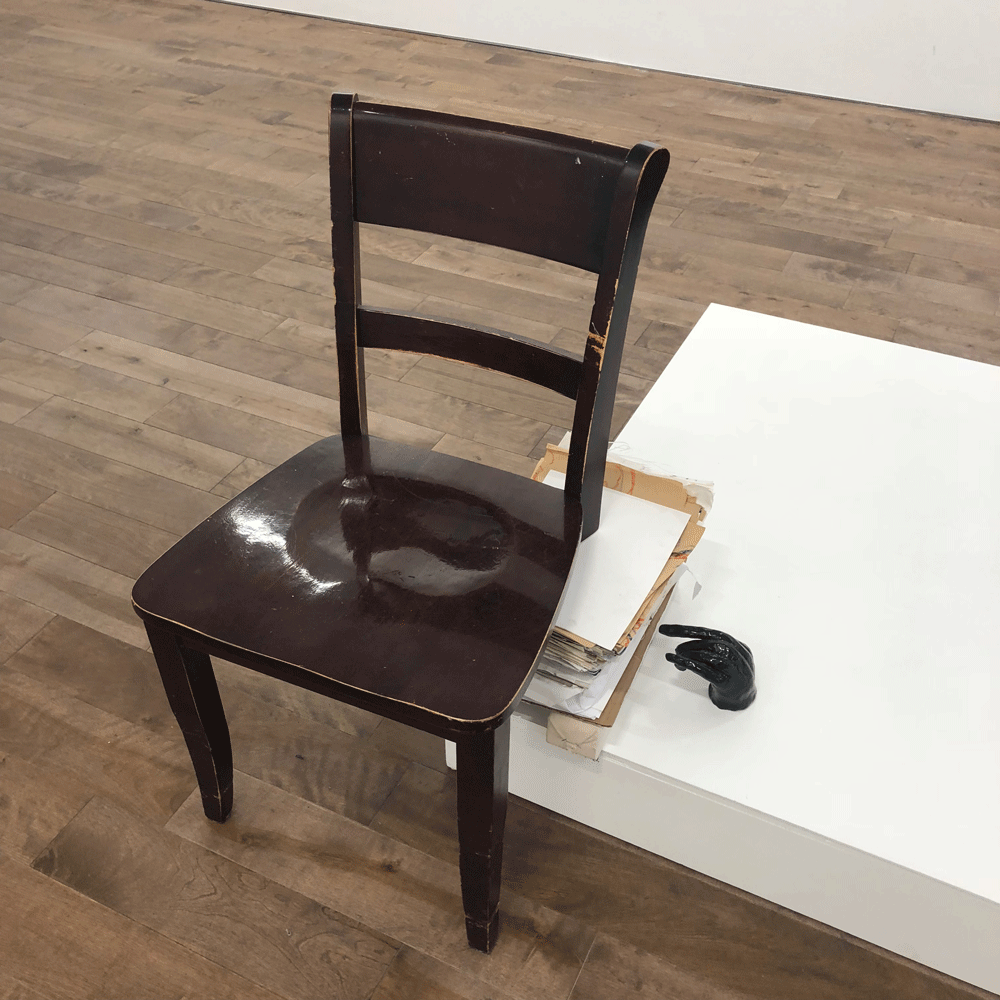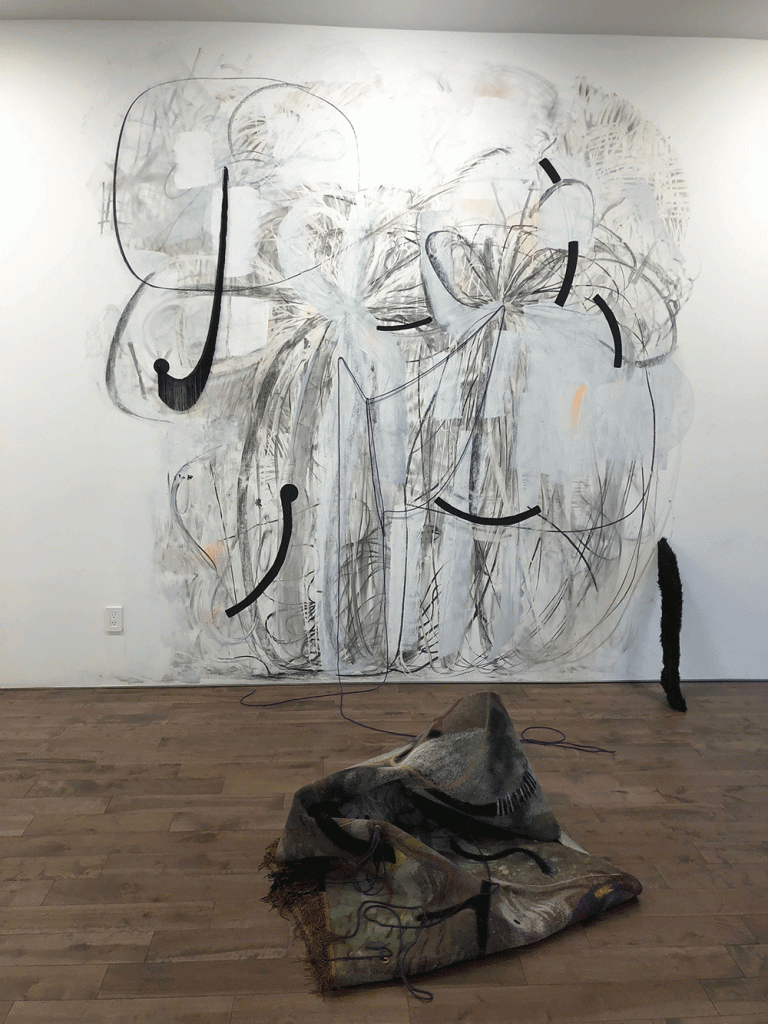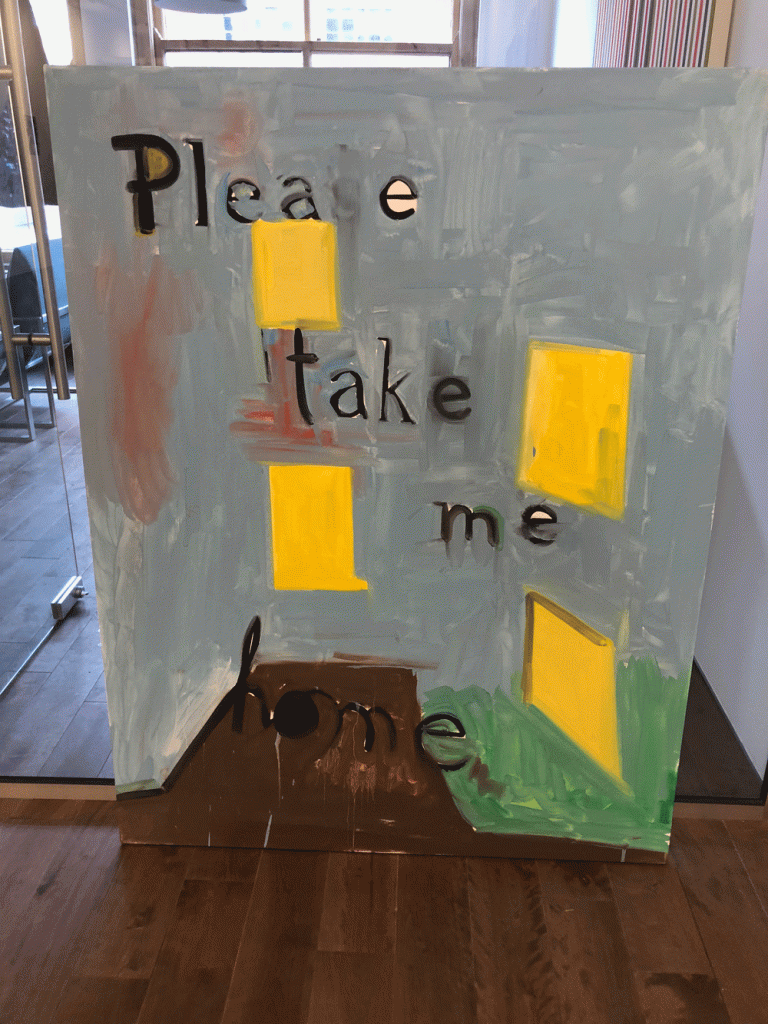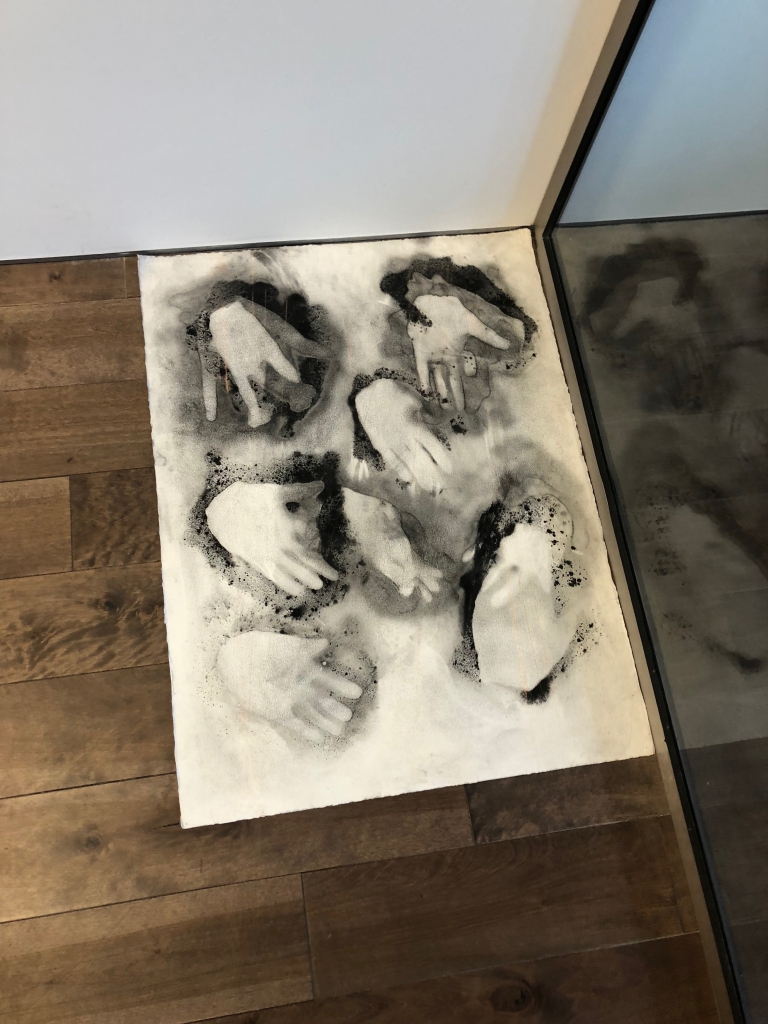Malcolm McCormick, Mathieu Lacroix, Rachel Crummey, Michelle Furlong
Fait ou défait, c’est idem
Galerie Deux Poissons
July 12-August 25, 2018
What I found most striking about Fait ou défait, c’est idem, Galerie Deux Poisson’s fourth show, was how collaborative it was, how well the works of these four artists worked in a sort of humble synergy that was at once nameless and named. The show was curated by artist and writer Benjamin Klein, and the curation was strong in this group show; I find group exhibitions are exceedingly hard to pull off, as they too often seem forced, like a gaggle of people compelled to hang out awkwardly. Either they don’t seem to relate at all or they are gathered simply by common theme or medium, having nothing else to bind them together. In this exhibition, however, that was not the case. It had a real grassroots feeling, a sense of true collaboration and excitement. I am going to refrain from describing each work individually; the spirit of this exhibition is the sense of unity and togetherness that makes all the pieces work as a whole.
Fait ou défait, c’est idem, translated as “done or undone is the same”, alludes to the process of art-making. How does one know when a piece is completed? Is it ever truly done? An artist can stop working at any point and call it finished, no one can ever truly know when a piece is completed, including, oftentimes, the artist. It becomes a choice, an intuition, or it could come with being fed up or having a deadline. The word faire in French means both “to do” and “to make”, so, evocatively, the show’s title could also declare, “made or unmade, it’s the same.” One’s making and one’s doing carry the seed in the same word, as well as its opposite, as from the moment we are born—or made— we start dying.
The first thing one would encounter when entering the gallery is, ironically, a painting by Malcolm McCormick entitled, The End. It’s roughly but tenderly composed, with black “photo corners” and white script declaring “The End” in the middle. It is plaintive, mock sentimental and also cute. Smears of mustard-paint allow one to see the underpainting as if through a screen.
If one doesn’t strictly make the rounds, the visitor would likely then notice the impressive installations at the room’s centre. On the floor is a piano-shaped wood and cloth structure titled The Sparrow on the Hill Sees the Fool Going Around by Malcolm McCormick, a painter who also works with drawing and installations. Inside are works on paper by Mathieu Lacroix and Rachel Crummey, and ceramic hands by Michelle Furlong, along with found objects. There is a play on collaboration here, music is more frequently made in a group, multiple instruments and players create greater complexity than one individual is capable of.
Behind this piece, on a white block rests a piece by Lacroix, another legless piece—do we have a leg to stand on without our friends and collaborators?—is a three-legged chair propped up by stacks of papers and drawings, with a ceramic hand by Michelle Furlong pointing to a spot in the stacks. After this, certainly one could not help but be drawn to the immense in situ mixed media wall piece and installation by Rachel Crummey and Michelle Furlong towards the back of the gallery, titled Experience no. 2, after a piece by John Cage. Layered with bold and gestural marks in charcoal, graphite powder, acrylic paint and spray paint, the eye follows the energy of two artists and one can’t help but visualize their process, working together, erasing the work of the other, wondering if they worked in harmony or at times, adversarily. I think of how Robert Rauschenberg came to de Kooning to ask him if he could erase one of his drawings, which was allowed. Klein told me that he witnessed the process, allowing the artists to work uninterrupted, and saw how many times it could be completed, yet a new movement and shift began. It seemed a process fraught with dynamism and energy. The piece is so energetic that it cannot be contained to the wall.
A large piece of cheap-looking wall-to-wall carpet was contorted on the floor and subjected to the treatment of paint, recalling Furlong’s crumpled painted canvases. Most of the works in this show walk a thin line between ugliness and beauty, humility and humour. A leg made of black faux fur projects from the wall, reminding me of Dada creations. The piece sports rope of a gaudy purple shade, connecting the wall to the folds of carpet like an umbilical cord, its colour standing in stark contrast to the rest of the piece’s monochrome.
A painted disc of carpet stands alone like punctation on the floor, and large strips of black velcro and fringe with what appear to be large black pasties could suggest a crude face. The sort of feminine grunge aesthetic of Crummey and the slick, cool aesthetic of Furlong make an uneasy but pleasing contrast which gives the work a sort of personhood, even beastiness. I imagined it being made with John Cage playing in the background, the artist’s gestures and erasures moving to the sound like the surges of a symphony.
Scattered throughout the exhibition are Michele Furlong’s shiny, black-glazed ceramic hands pointing, squatting and hiding. They made me think of Thing in the Addam’s family, and their ubiquitousness felt as if they were the same hand, everywhere. They seemed at times to be the hand of the curator, invisibly and gentling guiding your attention.
Rachel Crummey is an award-winning Toronto-based abstract artist (and writer) working with painting, drawing and installation. Her work is layered, rich, and informed. She is an emerging artist who received her MFA from the University of Guelph in 2014. Her work is most successful in series, and this exhibition has a few of her works on paper, oil pastels on paper and acrylic on board or canvas. Her play of lines and layering is often very graceful. As in Experience no. 2, her installations in charcoal and graphite look like traces left by a ghost or the residue of a spirit or slug, but it could also be a kind of unusual wallpaper, worn with time and peeled away in strips. Her small works in this show are subtle in comparison to the collaborative installation, and quite accurately she describes her work as a “softly moving web.” One of her most engaging pieces here is a network or lung of actively tangled blue lines, made from oil pastel on paper. Much of her work is very tender and touching, and improvisation plays a strong role in her practise.
Malcolm McCormick is a primarily a painter (and drawer) but is also a multi-disciplinary artist. He’s from Vancouver and came to Montreal as an MFA candidate at Concordia. He’s spoken of being interested in colour, the formal aspects of making, collage-style work and things that are non-monumental and subtle. His work is sometimes wryly humorous and it has a sensitive yet painterly touch.
Besides The End, another funny piece sits on the floor saying: Take Me Home. Another work is an invisible house where all you can see are illuminated windows and a hastily painted, blue-steel background with brown ground and green grass, uneven letters imploring the viewer. Does the artist wish to go home, or the painting? Every painting for sale in fact says this wordlessly, and it was charming to have it so imploringly stated as it wasn’t even hung. His other oil painting, Banging Your Head Against a Warm Rock was textured with pebbles and almonds. Overall, McCormick’s work is deceptively simple, endearingly unostentatious, but skillfully handled and exploratory. McCormick said in an interview for his Kelowna Art Gallery duo exhibition in 2017: “ I like to make things that show an accumulation of decisions, and to leave traces of each decision so that the viewer can come into it and get a sense of how this thing developed over time”. The poetically titled, “Looking into His Ear” is a painting layered with transparent polkadot fabric, which leads one to visualize the layers and channels of the body and the delicacy of listening and looking.
Michelle Furlong is a Montreal-based multi-media artist, a recent graduate of Concordia’s Painting and Drawing program. Her work frequently consists of cutouts, textiles, texture, silhouettes, sharp contrasts, soft forms, stylized shapes and often, a cold, almost graphic, design. working primarily in paint, drawing and sculpture. Her work is largely concerned with the body, and hands are a major player. Her drawing sits on the floor in the corner, and is layered with outlines of hands, much as a child would use their own body as a starting point for making shapes and forms, and paint with their fingers. The effect of the ghost-like hands layered in blacks and whites and layers of charcoal, using negative space, and tucked away on the floor is at once haunting, playful, and evocative. There is a sense of ephemerality and whimsy, an awareness of temporality, of the limitations to the corporeal form in Furlong’s work. The hands play throughout the gallery, dark and shiny, slick, but not sinister.
Mathieu Lacroix is a Montreal native and multidisciplinary artist who received his BFA at UQAM. His grid of drawings here are reminiscent of architectural drawings, but also de Chirico. Some are on vellum, some on brown packing paper. There are elements of collage, and they are all cleverly composed, contemporarily-aware works that aren’t precious at all, which is why, I suspect, he titles all of these works NON ART. They fit perfectly with the drawing theme of the exhibition and the sense that creativity will continue and art will be made regardless of the means at one’s disposal. These are unpretentious drawings, and, despite being a rather conceptual show, Fait ou défait, c’est idem is also quite unpretentious and certainly process-oriented. Lacroix’s drawings contain a sense of resilience in their delicacy. His work uses reclaimed and recycled materials such as cardboard, ordinary, cheap substances. Art can and will continue without expensive materials and resources that often make it the domain of the privileged. Lacroix’s playful sculpture, NON ART: Chair, calls to mind the absurdity of Dada, a three-legged chair. Is it a comment on academia? The third leg is made of theory, of drawings, of studies. All of his works in this show are labeled emphatically NON ART, and then given a secondary title, in this case, NON ART: Chair. As an artist he to seek to connect to the ordinary and mundane through his subject and media, then thwart our expectations. These drawings engage with formal abstraction and imaginary space. We see a square building with grass growing out of its centre, long black hair pouring down like a waterfall; we see what may be a railroad station with water emerging through it being transformed in shape by its passage through the building, the rails of which pour with light, a power station, an A frame building overruled by a flow chart, a collision of realities and geometries, an unusual combination of formal fascination and dreamy imagination. They could be diagrams made on acid or instructions for or by aliens for human society.
The works here as a group, and even individually, don’t say “I, I” they say “us, we”. There is a particularly Montrealaise spirit here, a sort of “struggling artist”, communal sensibility of resourcefulness, resilience and joie de vivre. There is strong sense of line, of hesitant but necessary declaration and bold erasure. The marks made by the individual on the world, the lines that tie us together. The connections. The overlap, the influence. The give and take. This exciting and ground-breaking exhibition is a sign of innovative work both in artistic production, support for emerging artists and dynamic curation taking place at Galerie Deux Poissons and bodes well for future developments. Galerie Deux Poissons is a blessing for the artistic community of Montreal for its role in maintaining the importance of the Belgo Building as a Montreal landmark which has recently lost some important galleries.
